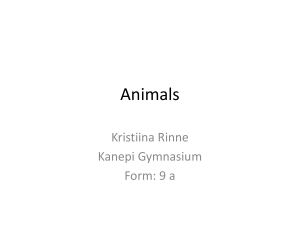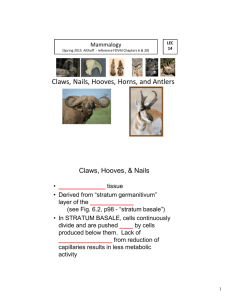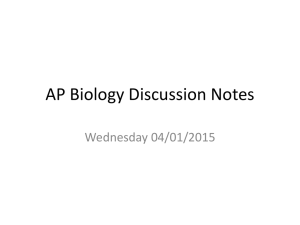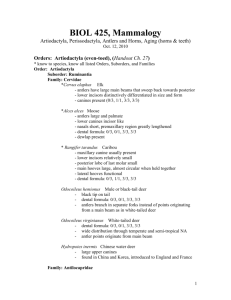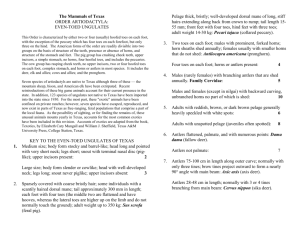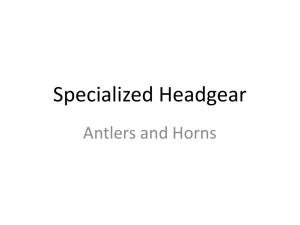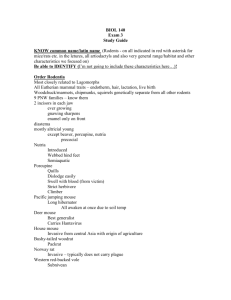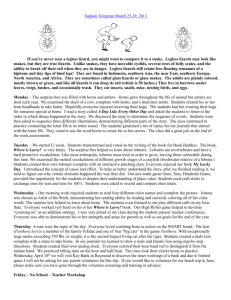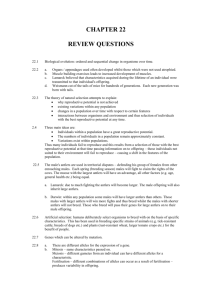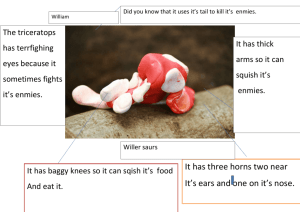Physical Properties of Antlers and Horns
advertisement
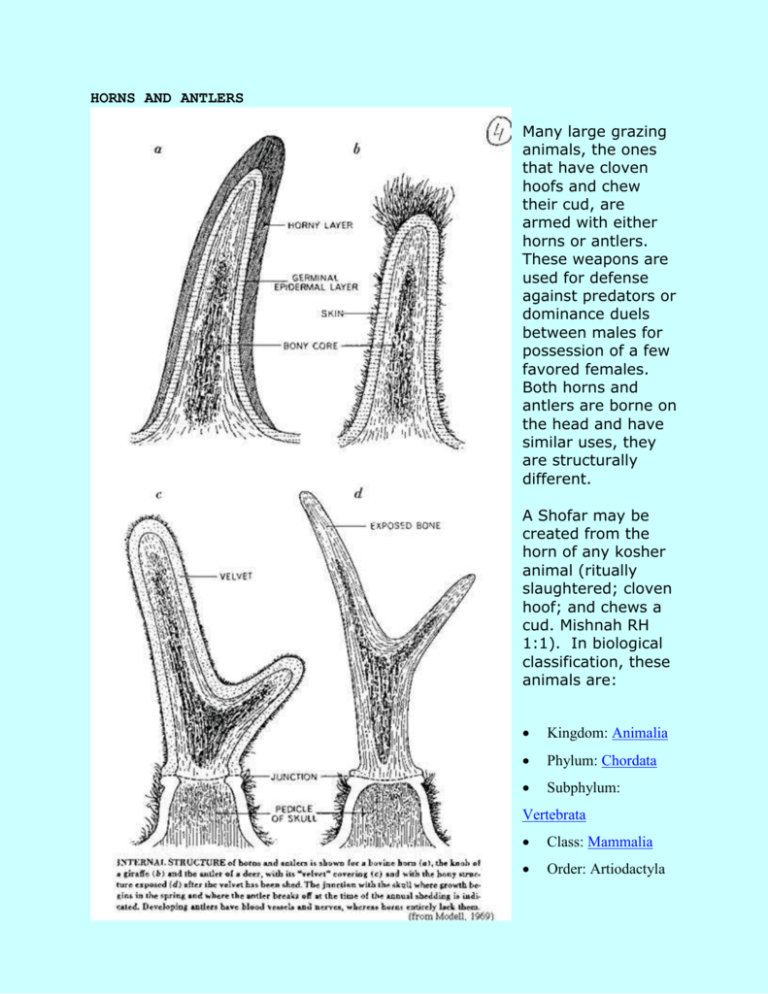
HORNS AND ANTLERS Many large grazing animals, the ones that have cloven hoofs and chew their cud, are armed with either horns or antlers. These weapons are used for defense against predators or dominance duels between males for possession of a few favored females. Both horns and antlers are borne on the head and have similar uses, they are structurally different. A Shofar may be created from the horn of any kosher animal (ritually slaughtered; cloven hoof; and chews a cud. Mishnah RH 1:1). In biological classification, these animals are: Kingdom: Animalia Phylum: Chordata Subphylum: Vertebrata Class: Mammalia Order: Artiodactyla Family: Bovidae Artiodactyls are paraxonic, that is, the plane of symmetry of each foot passes between the third and fourth digits. (cloven hoof). In all species the number of digits is reduced at least by the loss of the first digit, and the second and fifth digits are small in many. The third and fourth digits, however, remain large and bear weight in all artiodactyls. Artiodactyls stand in contrast to the "odd-toed ungulates," the Perissodactyla, where the plane of symmetry runs down the third toe. The most extreme toe reduction appears in antelope and deer, which have just two functional (weight-bearing) digits on each foot. Most artiodactyls have modified stomachs, the extreme case being that of groups such as antelope and deer, which have distinctive, four-chambered stomachs. This arrangement appears to be an adaptation that allows members of these groups to make use of microorganisms to decompose cellulose into digestible components. Artiodactyls are usually divided into several suborders: Suiformes These animals do not ruminate (chew their cud), and their stomachs may be simple and one-chambered or have up to three chambers. Tylopoda contains a single living family, the Camelidae. Modern tylopods have a 3-chambered, ruminating stomach. Their third and fourth metapodials are fused near the body but separate distally, forming a Y-shaped cannon bone. Ruminantia. This last suborder includes the families Tragulidae, Giraffidae, Cervidae, Moschidae, Antilocapridae, and Bovidae. This suborder is characterized by a series of traits including missing upper incisors, often (but not always) reduced or absent upper canines, selenodont cheek teeth, a 3 or 4-chambered stomach, and third and fourth metapodials usually partially or completely fused. The bovids include such diverse forms as gazelles, African antelope, buffalo, mountain goats, and domesticated species such as cattle, sheep, and goats. The family includes 137 species in 45 genera, and its members range through Africa, much of Europe and Asia, and North America. Modern bovids are most diverse by far, however, in Africa. All bovids have a four-chambered stomach and digest cellulose through bacterial fermentation. http://animaldiversity.ummz.umich.edu/site/accounts/information/Animalia.html. Accessed 6/14/04 Horns Horns, in contrast to antlers, are unbranched. They are hollow horny sheaths enclosing pointed bony cores that arise from the front of the skull. These sheaths are made of keratin, the same substance as our fingernails. They continue to grow throughout the life of the animal and are never shed. Horns are commonly found in both sexes of a species and are always in pairs. The unicorn, that one-horned creature pictured in the British royal coat of arms is strictly mythological. Antlers Antlers are the crowning glory of the males of the deer family. In this continent they are borne by the bull moose, the bull elk or wapiti, and the bucks of the whitetail, blacktail and mule deer. Caribou and reindeer live in the far North and both sexes have antlers. Amazingly, the solid bony antlers of all these are shed each year. For example, the whitetail buck drops his in midwinter or early spring. Soon, a new pair begins to form as furry knobs that rapidly expand into the curving and branching shape of the mature structures. During this growth period, the antlers are soft, covered with a velvety skin, have a rich blood supply, and are quite sensitive. By late summer the blood supply stops and the "velvet" begins to dry up and peel off. Then his antlers harden into bone which he polishes by rubbing against trees and branches -- probably because they itch. Beginning with prehistoric humans, horns and antlers have had many uses. Eskimos shaped spoons and dippers from musk ox horns. Indians made hunting bows from the bighorn, garden tools from elk antlers, and spear points from deer. Powder horns for muzzle-loading guns came from cows and the ancient shofar, or ram's horn, is still blown in Jewish religious rites. http://www.newton.dep.anl.gov/natbltn/700-799/nb730.htm. Accessed June 14,2004.
